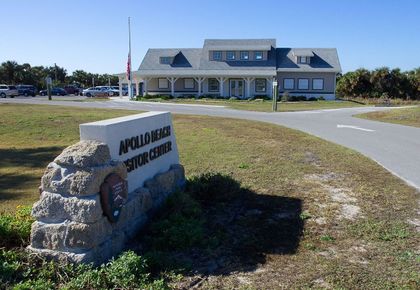Canaveral National Seashore: Difference between revisions
mNo edit summary |
mNo edit summary |
||
| Line 8: | Line 8: | ||
<div class="irlabout"><!-- About div --> | <div class="irlabout"><!-- About div --> | ||
==About== | ==About== | ||
Canaveral National Seashore was created through congressional legislation on January 3, 1975 (by Public Law 93-626) to preserve and protect the natural, scenic, scientific, ecological, archeological, and historical values and resources within the national seashore, and to provide for public outdoor recreational use and enjoyment of those resources. The national seashore | Canaveral National Seashore was created through congressional legislation on January 3, 1975 (by Public Law 93-626) to preserve and protect the natural, scenic, scientific, ecological, archeological, and historical values and resources within the national seashore, and to provide for public outdoor recreational use and enjoyment of those resources. | ||
The national seashore is managed by the National Park Service in partnership with the National Aeronautics and Space Administration (NASA), which owns approximately two-thirds of the national seashore, and the adjacent Merritt Island National Wildlife Refuge, which is administered by the U.S. Fish and Wildlife Refuge. | |||
</div><!-- End About div --> | </div><!-- End About div --> | ||
</div> <!-- END Content Top LEFT div --> | </div> <!-- END Content Top LEFT div --> | ||
| Line 19: | Line 21: | ||
<div class="irlcontentmiddle"><!-- Content Middle div --> | <div class="irlcontentmiddle"><!-- Content Middle div --> | ||
<div class="irlcontentmid1"><!-- Content Mid 1 div --> | <div class="irlcontentmid1"><!-- Content Mid 1 div --> | ||
Canaveral National Seashore's 24 miles of pristine, undeveloped beach represents an excellent example of a stable barrier beach island backed by a productive lagoon system. The seashore is comprised of a barrier island ecosytem and contains nearly 58,000 acres of bar-built barrier island, open lagoon, coastal hammock, pine flatwoods, and offshore waters. The seashore is prime habitat for many threatened and endangered species and provides nesting beaches for several thousand protected marine turtles. | |||
Canaveral's barrier island is the eastern boundary of Mosquito Lagoon. The lagoon encompasses more than two-thirds of the national seashore, and is designated an estuary of national significance. It is one of the most diverse and productive estuaries in North America. | |||
The Canaveral seashore contains cultural resources that reflect human history in the Florida peninsula from 2000 BC to early 20th century Florida settlement. | |||
The Canaveral National Seashore northern entrance is at Apollo Beach in Volusia County's New Symyrna. The southern entrance is at Playalinda Beach, due east of Titusville in Brevard County. Both visitor centers are usually open 9am-5pm. The beach is open from 6am until dusk. Admission is $15 for automobiles and $10 for motorcycles. Visit the [https://www.nps.gov/cana/index.htm Canaveral National Seashore website] for current news and information. | |||
<div class="irlvideo"><!-- Video div --> | <div class="irlvideo"><!-- Video div --> | ||
==Video== | ==Video== | ||
Revision as of 15:20, November 14, 2019
Subtitle
About
Canaveral National Seashore was created through congressional legislation on January 3, 1975 (by Public Law 93-626) to preserve and protect the natural, scenic, scientific, ecological, archeological, and historical values and resources within the national seashore, and to provide for public outdoor recreational use and enjoyment of those resources.
The national seashore is managed by the National Park Service in partnership with the National Aeronautics and Space Administration (NASA), which owns approximately two-thirds of the national seashore, and the adjacent Merritt Island National Wildlife Refuge, which is administered by the U.S. Fish and Wildlife Refuge.
Canaveral National Seashore's 24 miles of pristine, undeveloped beach represents an excellent example of a stable barrier beach island backed by a productive lagoon system. The seashore is comprised of a barrier island ecosytem and contains nearly 58,000 acres of bar-built barrier island, open lagoon, coastal hammock, pine flatwoods, and offshore waters. The seashore is prime habitat for many threatened and endangered species and provides nesting beaches for several thousand protected marine turtles.
Canaveral's barrier island is the eastern boundary of Mosquito Lagoon. The lagoon encompasses more than two-thirds of the national seashore, and is designated an estuary of national significance. It is one of the most diverse and productive estuaries in North America.
The Canaveral seashore contains cultural resources that reflect human history in the Florida peninsula from 2000 BC to early 20th century Florida settlement.
The Canaveral National Seashore northern entrance is at Apollo Beach in Volusia County's New Symyrna. The southern entrance is at Playalinda Beach, due east of Titusville in Brevard County. Both visitor centers are usually open 9am-5pm. The beach is open from 6am until dusk. Admission is $15 for automobiles and $10 for motorcycles. Visit the Canaveral National Seashore website for current news and information.

